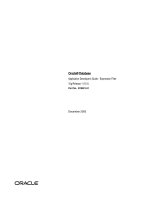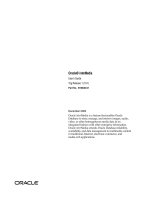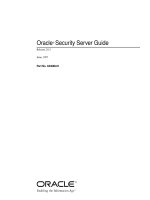Tài liệu Danisco Brewing Enzyme Guide pot
Bạn đang xem bản rút gọn của tài liệu. Xem và tải ngay bản đầy đủ của tài liệu tại đây (861.79 KB, 30 trang )
Danisco Brewing
Enzyme Guide
We use ”Imagine with us” to reect the heart of our food enzyme
business. The words invite people to join us on a journey of imagination,
discovery and opportunity in the world of food and beverage enzymes.
They describe a hotspot of innovation, staffed by knowledgeable and
imaginative people. At the same time, “Imagine with us” communicates
our constant drive to break new ground and make technological
advancements easy to implement for our customers.
Imagine with us
Join us
on a journey of
imagination
Page of Content
Check your brewhouse performance 4
Danisco’s brewing enzyme capabilities 5
Enzymes and brewing 6
The brewing process & possible challenges 8
Prot from the power of enzymes 10
Challenge: High performance in brewing with local raw materials 11
Challenge: Consistent mashing 12
Product solution: Alphalase
®
or AMYLEX
®
13
Challenge: Cost-efcient & consistent adjunct cooking 14
Product solution: AMYLEX
®
15
Challenge: Improved mash separation & beer ltration 16
Product solution: LAMINEX
®
17
Challenge: Increased fermentability & controlled attenuation 18
Product solution: DIAZYME
®
X4 & DIAZYME
®
P10 19
Danisco’s brewing enzymes – core products 20
Getting started – what do I need to use brewing enzymes? 22
High performance & sustainability 23
Safe use of bioproducts in Danisco’s enzyme production 24
Brewing terms 25
Glossary 26
About Danisco 30
4
Content
Is your
mash separation
equipment a
bottleneck?
Check your
brewhouse performance
If you can answer yes to any of the questions below, the use of our
enzymes will benet your brewhouse:
• Is your brewhouse yield <98%
• Do you experience an inconsistent process time?
• Do you have a hard time getting your adjuncts liqueed?
• Is your mash separation equipment a bottleneck?
• Are you interested in energy savings during your adjunct cooking?
• Do you experience low real degree of fermentation (RDF) or slow fermentation?
• Do you wish to boost your fermentation capacity through very high gravity brewing?
• Do you want to produce low carb beer?
• Do you want to ensure consistent beer ltration?
• Are you interested in using local raw materials?
• Do you want to secure consistent beer quality from inconsistent malt quality?
– depending on lack in raw material
On the following pages you can learn more about how Danisco’s Brewing enzymes can help you overcome
these challenges.
5
Content
Danisco’s brewing
enzyme capabilities
Choose the enzyme provider that knows most
about food and beverages
Every day, somewhere around the world, our enzymes help brewing companies sharpen their competitive edge. They
enable our customers to keep costs down yet maintain product quality and protability.
We have developed a specialised range of enzymes that maximise brewing efciency and create stable, high quality beer
with great mouthfeel. Supported by a unique knowledge base and hands-on industry specialists, these solutions are
uniquely able to improve your business by securing:
• Consistently high quality
• Lower raw material costs
• Faster production process
• Lower energy consumption
• More appealing mouthfeel
• Enhanced sustainability
Imagine your business with Danisco’s capabilities
As a leading food ingredients manufacturer, Danisco knows more about food and beverage than any other enzyme
provider in the world. By talking with us, you will be able to discover, source and apply know-how from the entire food
system to the challenges your business faces.
We invest heavily in expanding this knowledge and making it accessible for our customers via our global network of
research and development centres. And we use it to help you identify and prot from new opportunities, too.
Danisco has facilities in more than 45 countries. For brewing, we have application centres in Brabrand/Denmark and
Shanghai/China. Our dedicated brewing R&D group is also located in Brabrand and works closely with our grain process-
ing and biofuel R&D groups in Leiden/Holland, Palo Alto/US and Shanghai/China. We produce enzymes at seven plants
around the world.
Did you know
All enzymes are proteins
and bio-degradable
6
Content
Enzymes and brewing
What are enzymes?
Enzymes are proteins present in all living cells, such as plants, animals, human beings and microorganisms. They function as
catalysts for the thousands of chemical reactions that take place in these cells.
As natural substances, enzymes are ideal ingredients for use in the modern food industry. By adding modern science/bio-
technology and knowledge to nature’s own material, Danisco is able to mimic and speed up the natural enzymatic proc-
ess. The result is enzymes as they might appear in natural settings but with an accelerated effect that brings value-adding
and previously unattainable functionalities to food products.
Enzymes are processing aids and not additives. Once the enzyme has done its work, it is inactivated, becoming just
another protein.
How can brewing benet from enzymes?
The brewing process is dependent on enzymes. The enzymes from malt (malted barley) catalyse the hydrolysis of the
endosperm cell walls, starch, proteins and lipids during mashing. Yeast itself may be considered a complex package of
enzymes that catalyse the reactions necessary for converting fermentable sugars into alcohol.
Support & control of inconsistent raw material quality
Malted barley is the traditional source of enzymes for brewing. However, brewers are often faced with malts of inconsist-
ent quality. This can pose challenges such as reduced extract yield, poor mash separation, slow or incomplete fermenta-
tion, difcult beer ltration and inferior beer in terms of taste and stability.
To resolve this situation and achieve consistent, efcient brewhouse performance, exogenous enzymes can be used to
supplement the malt enzymes and, in some cases, provide additional activities not inherently present in the malt. In addi-
tion, these enzymes enable efcient utilisation of a wide range of adjuncts, such as unmalted barley, corn, wheat, sorghum
and rice, and can be used to produce beers with specic attributes, such as highly attenuated or low carb beers.
Danisco offers a portfolio of innovative enzymes that allow brewers worldwide to develop and maintain cost-effective,
consistent processes and high product quality with varying local raw materials.
Use our brewing solutions to optimise:
• extract yield
• adjunct liquefaction
• mash separation
• fermentation
• beer ltration
• stabilisation and production of speciality beers
What is the origin of enzymes used for brewing?
Our enzymes for brewing applications are of microbial origin, produced by fungi or bacteria. The main reason for using
enzymes of microbial origin is their ability to enable commercial production of safe, high quality products.
7
Content
What inuences enzyme activity?
• Temperature: Each enzyme has an optimum temperature that gives the highest number of enzyme/substrate interac-
tions. The optimum temperature varies according to the process conditions, including substrate concentration, pH and
the presence/absence of various salts
• Reaction time
• pH: each enzyme has an optimum pH for the highest number of enzyme/substrate interactions. The optimum is
dependent on the temperature.
• Enzyme concentration (dosage)
• Substrate concentration
The optimum
is dependent on
the temperature
8
Content
The brewing process
& possible challenges
Steps in the brewing process include malting, milling, mashing, mash separation, boiling, fermentation, conditioning, ltration
and lling. The diagram below gives an overview of the process and where enzymes can be added.
Malting
Malting prepares cereals for brewing by activating the endogenous enzymes.
Malt contains all the enzymes necessary to hydrolyse starch into fermentable sugars, but:
• the malt debranching enzyme is very heat labile and is inactivated in mashing at the temperatures required to gelatinise
the starch
• α(1→6) bonds and some adjacent α(1→4) bonds are not hydrolysed, which means the maximum fermentability in
normal beers is typically <70 % RDF
Milling
During milling, the kernels are crushed to make the starch accessible to the enzymes and facilitate sparging and mash
separation.
Cereal/malt
Milling
Cereal cooker Mash tun Wort kettle Whirlpool Heat exchanger
Lauter tun
Mash lter
Fermentation tank Maturation tank Beer ltration Filling
DIAZYME
®
• AMYLEX
®
• LAMINEX
®
• DIAZYME
®
• ALPHALASE
®
AMYLEX
®
9
Content
Mashing & mash separation
Starch is converted into fermentable sugar. Having breaks at different temperatures the different malt enzymes can be
more or less effective in the modication of the substrate. Protein and non-starch polysaccharides are partly modied.
Prior to mash separation, the temperature of the mash is raised to 74-80°C (165-176°F) to inactivate the malt enzyme.
The mash is separated into wort and spent grains. First, the wort is separated from the mash and sparging water is used
to recover additional soluble extract.
Brewhouse performance may be adversely affected by:
• the presence of high molecular weight non-starch polysaccharides, which have a negative effect on mash wort separation
• small starch granules that may not be gelatinised at normal mashing saccharication temperatures, resulting in lower
extract yield and potentially starch-positive extract.
Wort boiling & cooling
The wort is transferred into a large tank - a “copper” or kettle where it is boiled with hops. Many chemical reactions take
place during wort boiling, which also serves to inactivate the enzymes. Afterwards, the trub (precipitated sediments) are
normally removed in a whirlpool.
The wort is then cooled using a heat exchanger, yeast is pitched, and everything is transferred to the fermenter.
Fermentation
During fermentation the fermentable extract is converted into alcohol and carbon dioxide. Other components that add
character to the beer are produced as well.
Maturation
The green beer is conditioned, the avour becomes smoother, and off-avours are eliminated.
Beer processing
The matured beer is ltered and made ready for lling.
Pasteurisation
Beer is normally pasteurised before or after lling.
Did you know
Enzymes are nature’s
own catalysts speeding up
processes without being
consumed in the process.
10
Content
Prot from the
power of enzymes
We have developed a specialised range of enzymes to maximise brewery efciency and create stable beer without com-
promising on avour and clarity. Supplementing the enzymes naturally present in malt, they increase extract volume and
relieve processing bottlenecks during mash separation and beer ltration, maximising separation and optimising through-
put. At the same time, the increased conversion of starch into fermentable carbohydrate enhances the malt extract and
the quality of the nished beer.
Consumer demand for greater choice and quality has sent brewers worldwide on a never-ending quest to create spe-
ciality beers and develop new styles with exclusive avour characteristics. Their mission has inspired the growing use of
cereals other than malt, including corn, rice, wheat and unmalted barley, which contain less enzymes of their own and may
require cooking before addition to the mash. The addition of our enzymes ensures efcient starch extraction, wort viscos-
ity reduction and a sufcient level of free amino nitrogen - all in support of fermentation.
11
Content
High performance in brewing
with local raw materials
Locally grown raw materials, such as rice, corn and sorghum, are clearly an economical and climate-friendly choice, espe-
cially in tropical and sub-tropical regions.
Malt has a high natural content of enzymes and is capable of breaking down starch unaided, making sugars available
for conversion into alcohol. Rice, corn and other starch-rich adjuncts, on the other hand, do not contain the necessary
amount of enzymes for brewing. In situations when the malt is of poor quality or the recipe is based on more than 30%
alternative cereals, additional enzymes are required to ensure maximum raw material yield, eliminate ltration bottlenecks
and secure the uniform, high quality of the nal beer.
Commercial brewing alpha-amylases have several advantages over natural malt enzymes. One is their high heat stability,
which speeds up starch liquefaction and, consequently, gives increased productivity. Due to their high efciency, brew-
ing α-amylases can be added at relatively low dosages, which means more non-malt cereals can be processed in a single
batch. At the same time, there is no risk of residual starch being carried over from the cereal cooker to the mash vessel.
The α-amylases signicantly reduce viscosity – the rst requirement for a smooth ltration process without bottlenecks.
Further viscosity reduction is achieved using complexes of β-glucanase and xylanase. These complexes have a number of
functionalities. In addition to offsetting variations in raw material quality, they optimise wort separation and enhance ltration.
Challenge
1
12
Content
Consistent mashing
To secure cost-efcient beer production, good brewhouse performance is essential. Performance can be adversely
affected by a series of factors. These include high molecular weight non-starch polysaccharides, which hamper mash
separation, small starch granules that may not gelatinise at normal mashing saccharication temperatures, and incomplete
proteolysis, possibly resulting in low α-amino nitrogen – a problem during fermentation.
Time and temperature are critical to all steps. Insufcient time or an excessively high temperature during proteolysis will
lead to incomplete breakdown of the proteins and the β-glucan matrix surrounding the starch granules, reducing the
amount of starch available for conversion and resulting in low extract yield. If the temperature is too low at the nishing
stage, ungelatinised residual starch may be carried through to the kettle. If the temperature is too high, the α-amylase will
be denaturated and, although the residual starch may be gelatinised, it will not have been converted into sugar.
The presence of unconverted starch carried through from the mash results in low yields and the potential for starch haze
in the nished beer. This can be avoided by the addition of a more heat stable α-amylase to the mash.
Additional proteolytic activity may be required when brewing with certain adjuncts or inconsistent quality malts to opti-
mise the rate of fermentation and attenuation.
Challenge
2
13
Content
Alphalase
®
or AMYLEX
®
Our Alphalase
®
enzyme complexes supplement natural enzymes for consistent mashing, particularly when using unmalted
barley or other adjuncts. Extraction is optimised, efciency improved and costs reduced.
Alphalase
®
AP3
Alphalase
®
AP3 is a mashing enzyme blend that contains α-amylase, β-glucanase and proteinase activities for consist-
ent malt-like performance in the brewhouse. This enzyme has been specically developed for use when signicant levels
of adjuncts are included or the malt level or quality is inadequate and the mash needs to be supplemented with extra
enzyme activity.
AMYLEX
®
4T
This α-amylase is much more heat-stable than malt amylases, allowing shorter process times, simpler liquefaction and
overall increases in productivity.
Because of the relatively low amount of heat-stable α-amylase required compared to malt, more adjunct may be accom-
modated in the cooker. When using a heat stable α-amylase, there is no risk of residual starch being carried over from the
cereal cooker to the mash vessel. Finally, the malt and its enzymes can be preserved for the mashing saccharication process.
Alphalase
®
AP3
kg/MT barley
Viscosity
(12 ˚Plato)
mPa.s
β-glucan
mg/l
Filtration
(volume/30 min.)
ml
Extract
˚Plato
FAN
ppm
0.00 2.4913 2850 43 15.55 133
0.50 1.8175 1580 77 16.45 166
1.00 1.7683 555 90 16.30 173
2.00 1.7481 20 107 16.50 191
Table 2: Effect of Alphalase
®
AP3 with 30% barley inclusion
Product Enzyme Functionality/benet
Dosage in the mash,
kg/MT of grist
AMYLEX
®
4T
α-amylase
Bacillus licheniformis
Provides heat stable
performance in the mash
and cereal cooker; secures
efcient starch liquefaction
0.01-0.05
Alphalase
®
AP3
α-amylase, β-glucanase,
neutral protease
Bacillus subtilis,
Bacillus amyloliquifaciens
Gives efcient starch lique-
faction in mash, improves
extract yields, enables high
adjunct inclusion; increases
soluble protein and free
amino amino nitrogen
(FAN)
0.2-1
Table 1: Danisco’s rst choice AMYLEX
®
and Alphalase
®
products for mash addition
Product solution for challenge
2
+
1
14
Content
Cost-efcient & consistent adjunct cooking
Cereals such as corn and rice are common brewing adjuncts. The starch gelatinisation temperatures required by these
cereals are higher than those used for saccharication in mashing.
To ensure complete gelatinisation and liquefaction of the adjunct starch, it is necessary to cook the adjunct before adding
to the mash. Liquefaction of the adjunct is traditionally carried out by adding some malt to the adjunct cooker. The cereal
adjunct is often mashed in with the enzyme at a relatively low initial temperature of 45–55°C. The cooker is then heated
to >90°C for 15–20 minutes to complete the gelatinisation and liquefaction process. The cooked adjunct is added to the
mash vessel to raise the combined temperature of the mash to typically 62–65°C.
The malt α-amylase is not sufciently heat stable to liquefy the starch at the higher temperatures used in the adjunct
cooker. A more efcient method is to use a heat-stable α-amylase, such as AMYLEX
®
4T or AMYLEX
®
3T. This gives the
following benets:
• Up to 50-minute reduction in process time for cereal cooking
• Up to 25% less energy consumption during adjunct cooking
• Reduced raw material costs in cereal brewing
• Increased extract yields
• Higher adjunct inclusions in the cereal cooker
• Higher solids content (up to 32% due to lower water to grist ratio) than with traditional brewing
• Signicantly reduced viscosity and fouling during cereal cooker operations
Challenge
3
15
Content
AMYLEX
®
These liquefying α-amylases are used in mash and cereal cooker applications, giving efcient starch liquefaction and
reduced viscosity. Our AMYLEX
®
range includes highly heat-stable enzymes.
AMYLEX
®
This α-amylase is much more heat-stable than malt amylases, allowing for shorter process times, simpler liquefaction and
overall increases in productivity.
Because of the relatively low amount of heat-stable α-amylase required compared to malt, more adjunct may be accom-
modated in the cooker. When using a heat-stable α-amylase, there is no risk of residual starch being carried over from
the cereal cooker to the mash vessel. The presence of residual starch has implications for extract, beer ltration and haze
formation. Finally, the malt and its enzymes can be preserved for the mashing saccharication process.
Product Enzyme/strain Functionality/benet
Dosage in the cereal
cooker kg/MT adjunct
AMYLEX
®
4T
Heat stable α-amylase
Bacillus licheniformis (GMM
organism)
Provides heat stable
performance in the mash
and cereal cooker; secures
efcient starch liquefaction
0.25 - 0.50
AMYLEX
®
3T
Heat stable α-amylase
Bacillus licheniformis
(self cloned)
Provides heat-stable
performance in the mash
or cereal cooker, secures
efcient starch liquefaction
when no special request for
high solids in the adjunct
cooker
0.40 - 0.80
AMYLEX
®
BT2
Heat stable α-amylase
Geobacillus stearother-
mophilus (traditional non-
GMM)
Provides heat-stable
performance in the mash
or cereal cooker, secures
efcient starch liquefaction
0.40 - 0.80
Table 3: Danisco’s rst choice AMYLEX
®
products for cereal/adjunct cooking
Product solution for challenge
3
16
Content
Improved mash separation & beer ltration
Mash separation is a common process bottleneck in the brewhouse, where poor lautering or mash ltration results in
reduced production capacity. It can also lead to lower extract yields and have a negative impact on wort quality, leading to
beer ltration problems and avour and stability issues. Non-starch polysaccharides are solubilised from the malt, barley
or other cereals during cooking and mashing. This increases wort viscosity and also creates other problems if carried
onwards undegraded. The most signicant non-starch polysaccharide from malt and barley is β-glucan, while arabinoxylans
(pentosans) predominate in wheat and rye.
In addition to improving mash separation, the degradation of β-glucan can benet extract yield and beer ltration, leading
to a reduced consumption of ltration aids and lower energy costs.
Danisco has developed the LAMINEX
®
range of β-glucanase/xylanase enzyme preparations primarily for use in mashing
or fermentation.
Challenge
Did you know
Enzyme can be
tailored for very
specic require-
ments.
4
17
Content
LAMINEX
®
Containing β-glucanases and xylanases, LAMINEX
®
enzymes are an ideal ltration aid, reducing viscosity, increasing solid-
liquid separation yield and improving processing efciency.
LAMINEX
®
Super 3G
LAMINEX
®
Super 3G is a concentrated enzyme complex specially designed to improve mash separation in the brew-
house by degrading the β-glucans, xylans (pentosans) and other non-starch polysaccharides responsible for higher viscosi-
ties, hazes or poor dewatering of spent grains. In addition, LAMINEX
®
Super 3G improves beer ltration.
LAMINEX
®
Super 3G is added directly to the mash.
Product solution for challenge
Dose rate
kg/MT of grist
Average ltration rate
at lautering
(l/h)
Viscosity adj
to 12°P
(mPa.s)
[β-glucan]
(mg/l)
0.00 112 1.80 567
0.10 126 1.67 296
0.20 128 1.61 150
Table 5: Effect of LAMINEX
®
Super 3G on wort ltration, wort viscosity and β-glucan
Product Enzyme/strain Functionality/benet
Dosage
kg/MT of grist
LAMINEX
®
Super 3G
β- glucanase/xylanase
Penicillium funiculosum,
Trichoderma reesei
Reduces wort viscosity and
β-glucan, which improves
wort separation and beer
ltration
0.05 -0.25
Table 4: Danisco’s rst choise LAMINEX
®
enzyme
4
18
Content
Increased fermentability & controlled attenuation
Although malt can produce all the enzymes needed to hydrolyse starch into fermentable sugars, the debranching enzyme
– malt limit dextrinase – is very heat labile and inactivated when mashing at the temperatures required to gelatinise the
starch. Therefore, since the α(1→6) bonds and some adjacent α(1→4) bonds in amylopectin are not hydrolysed by the
malt α- and β-amylases, the maximum fermentability in normal beers is typically <70% RDF.
Challenge
5
19
Content
Product solution for challenge
DIAZYME
®
X4 & DIAZYME
®
P10
Exogenous enzymes, such as Danisco’s DIAZYME
®
range, can be used to control the fermentability and/or the sugar
prole of the wort. The brewer can produce a range of highly attenuated or low carbohydrate beers by adding these
enzymes either to the mash or during fermentation.
DIAZYME
®
X4
DIAZYME
®
X4 is a saccharifying glucoamylase that can hydrolyse α(1→
4) bonds and α(1→
6) bonds in starch. This
enzyme produces the biggest increase in fermentability, with values of up to 83% RDF when added to the mash.
DIAZYME
®
X4 enables ne control of attenuation to set values, enabling the production of highly attenuated beers.
Glucoamylase is relatively heat stable and, when used in the fermenter, may survive pasteurisation. For this reason, the
enzyme is commonly added to the mash.
In addition to DIAZYME
®
X4, Danisco’s pullulanase DIAZYME
®
P10 may be used to enhance the hydrolysis rate of the
α(1→6) bonds and increase the RDF to around 85%.
Dose rate
kg/MT grist
Initial extract
(°P)
RDF
(%)
Alcohol
(% ABV)
Energy in beer
Debrewed to 5% ABV
(kJ/100ml)
0.0 15.72 71.9 7.6 163
10.0 15.92 82.9 8.8 142
Table 7: Increasing real degree of fermentation using DIAZYME
®
X4
• RDF = Real Degree of Fermentation
• Mash prole: 140 minutes at 64°C then nish at 74°C
Product Enzyme/strain Functionality/
benet
Dosage in the
mash,
kg/MT of grist
Dosage in
fermentor, g/hl
beer or wort
DIAZYME
®
X4 glucoamylase
Aspergillus niger
Hydrolyses starch
into fermentable
sugars securing nely
controlled attenuation
and highly attenuated
beers
0.5-10 2-22
DIAZYME
®
P10 pullulanase
Bacillus licheniformis
Suitable for mash and
fermenter, improves
attenuation by de-
branching amylo-
pectin
0.5-2.0 1-2
Table 6. Danisco’s rst choise DIAZYME
®
products
5
20
Content
Danisco’s brewing enzymes
– core products
Product Enzyme Functionality/benet Product description
Alphalase
®
NP neutral protease
Bacillus amyloliquifaciens
Allows high adjunct inclu-
sion to mash, increases
soluble protein and FAN
isco.
com/epub/les/brewing%20
e-guide/alphalase_np.pdf
Alphalase
®
AP3
α-amylase, β-glucanase,
protease
Bacillus subtilis,
Bacillus amyloliquifaciens
Gives efcient starch lique-
faction in mash, improves
extract yields, enables high
adjunct inclusion, increases
soluble protein and free
amino nitrogen (FAN)
isco.
com/epub/les/brewing%20
e-guide/alphalase_ap3.pdf
Consistent mashing when using a high level of adjunct or malt
of instable quality
FUNCTIONALITY
Alphalase
®
Product Enzyme Functionality/benet Product description
AMYLEX
®
4T
α-amylase
Bacillus licheniformis
Provides heat-stable per-
formance in the
mash or cereal cooker,
secures efcient starch
liquefaction
isco.
com/epub/les/brewing%20
e-guide/amylex_4t.pdf
AMYLEX
®
3T
α-amylase
Bacillus licheniformis
Provides heat-stable per-
formance in the
mash or cereal cooker,
secures efcient starch
liquefaction when no special
request for high solids in
the adjunct cooker
isco.
com/epub/les/brewing%20
e-guide/amylex_3t.pdf
AMYLEX
®
BT2
α-amylase
Geobacillus stearother-
mophilus
Provides heat-stable per-
formance in the
mash or cereal cooker,
secures efcient starch
liquefaction
isco.
com/epub/les/brewing%20
e-guide/amylex_bt2.pdf
Improved starch liquefaction and extraction performance
with rapid viscosity reduction
FUNCTIONALITY
AMYLEX
®
21
Content
Ideal beer ltration aid for improved yield
and reduced energy costs
FUNCTIONALITY
LAMINEX
®
Product Enzyme Functionality/benet Product description
LAMINEX
®
Super 3G
β-glucanase/xylanase
Penicillium funiculosum,
Trichoderma reesei
Reduces wort viscosity and
β-glucan, which improves
wort separation and beer
ltration
isco.
com/epub/les/brewing%20
e-guide/laminex_super_3g.
LAMINEX
®
BG2
β-glucanase
Trichoderma reesei
Reduces wort viscosity and
β-glucan, which improves
wort separation and beer
ltration
isco.
com/epub/les/brewing%20
e-guide/laminex_bg2.pdf
LAMINEX
®
750
β-glucanase
Geosmithia emersonii
Provides heat-stable
performance in the mash
or cereal cooker. Reduces
wort viscosity and β-glucan,
which improves wort sepa-
ration and beer ltration
isco.
com/epub/les/brewing%20
e-guide/laminex_750.pdf
Efcient production of fermentable sugars and alcohol
and accurate attenuation control
FUNCTIONALITY
DIAZYME
®
Product Enzyme Functionality/benet Product description
DIAZYME
®
X4 glucoamylase
Aspergillus niger
Hydrolyses starch into
fermentable sugars securing
nely controlled attenuation
and highly attenuated beers
isco.
com/epub/les/brewing%20
e-guide/diazyme_x4.pdf
DIAZYME
®
FA
α-amylase
Aspergillus oryzae
Ensures hydrolysis of resid-
ual starch, removes starch
haze, improves attenuation
isco.
com/epub/les/brewing%20
e-guide/diazyme_fa.pdf
DIAZYME
®
P10 pullulanase
Bacillus licheniformis
Suitable for mash and
fermenter, improves
attenuation by de-branching
amylopectin
isco.
com/epub/les/brewing%20
e-guide/diazyme_p10.pdf
22
Content
Introducing enzymes to the brewhouse requires little or no capital investment. Nor is there any need for brewers
to alter their product labels – as a processing aid, enzymes do not need to be declared.
In short, using enzymes could not be easier.
Getting started – what do I need
to use brewing enzymes?
23
Content
At Danisco, food enzyme development focuses on developing sustainable solutions, including replacement of traditional
additives. The enzyme solutions will reduce the environmental impact of the food production process. An enzyme
reaction typically takes place at a lower temperature, reducing energy consumption during the manufacturing process.
Furthermore, the use of enzymes in food optimises raw material yield and extends the lifetime of consumer products
– providing cost savings and preserving natural resources.
In line with growing consumer interest in health and nutrition, the continuous development of food enzymes capable
of supporting bre-rich diets and controlling calories in beverages is an important part of our sustainability programme.
Improved utilisation of brewing raw materials
Danisco’s brewing enzymes increase raw material utilisation by securing a higher throughput with no compromise on
quality. Apart from increasing prot, the enzymes reduce the consumption of resources during manufacturing and limit
environmental impact.
Starch and cell wall degrading enzymes are used extensively to increase brewhouse yield and facilitate mash separation
and beer ltration. Increases in extract yield of up to 3% are, of course, of great interest to the brewer. The measurable
reduction in environmental impact is not only due to the reduced use of raw materials, but also to savings in energy
and water consumption in the brewhouse and beer processing area. Increased capacities can also be obtained without
investments. If unmalted cereals are used as raw materials, signicantly higher increases in extract yield can be obtained.
Optimised production & reduced water and energy consumption
Enzymes reduce production costs by increasing efciency and reducing water and energy consumption. In the brewing
industry, xylanases and glucanases are used routinely to facilitate ltration processes. The benets are shorter ltration
times and improved utilisation of lter material. This, in turn, leads to signicantly reduced consumption of energy and
water when cleaning and loading lters. The faster, easier ow in an optimised production setup saves time and increases
the production throughput.
High performance & sustainability
24
Content
Safe use of bioproducts in
Danisco’s enzyme production
Danisco can offer enzyme solutions produced by traditional methods or through the use of recombinant DNA technol-
ogy. Recognising the increasing demand for sustainable solutions, Danisco produces enzymes by fermenting genetically
modied microorgansims when the industry demands a certain performance. Enzymes produced by GMM technology
utilize production microorganisms that are non-toxic, non-pathogenic and the enzymes are safe for humans, animals
and the environment. We operate in full compliance with regulatory policies in all areas throughout our production and
product distribution.
The use of GMM technology gives a higher purity and production efciency. This secures the environmental benet of
reduced energy consumption and waste.
Did you know
Most enzymes are much
larger than the sub-
strates they act on, and
only a small portion of
the enzyme is directly
involved.
25
Content
Brewing terms
AE
Apparent extract (residual extract)
measured in ˚Plato
after fermentation
Wort/beer gravity is measured in
˚Plato or ˚Balling. Soft drinks and
juices are measured in ˚Brix.
RE
Real extract (residual extract)
measured in ˚Plato
after fermentation
hl
100 litres
Extract
Measured in ˚Plato
Mash
Water + malt (and adjuncts)
Wort
Solubilised extract
measured in ˚Plato
Spent grains
Solids from wort separation
Attentuation
Degree of fermentation
RDF
Real degree of fermentation
ABV
Alcohol by volume
HGB
High gravity brewing
Did you know
Human life
would be im-
possible with-
out enzymes.









